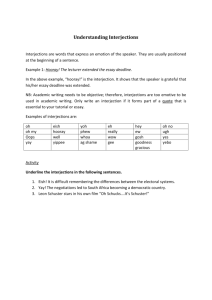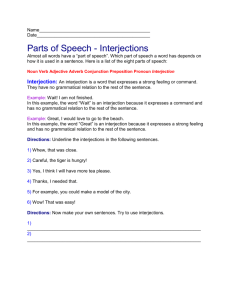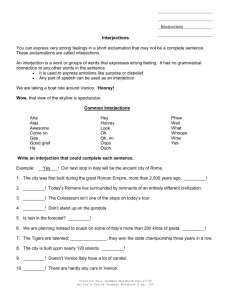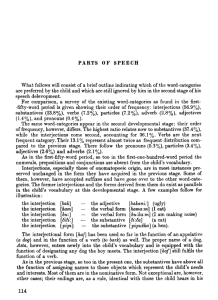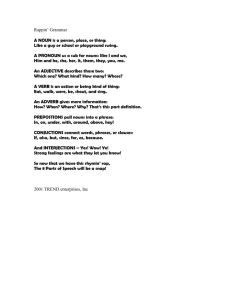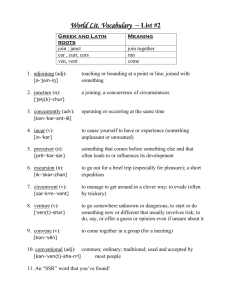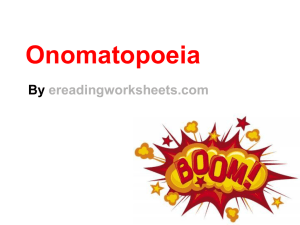Reading Lesson Plan
advertisement
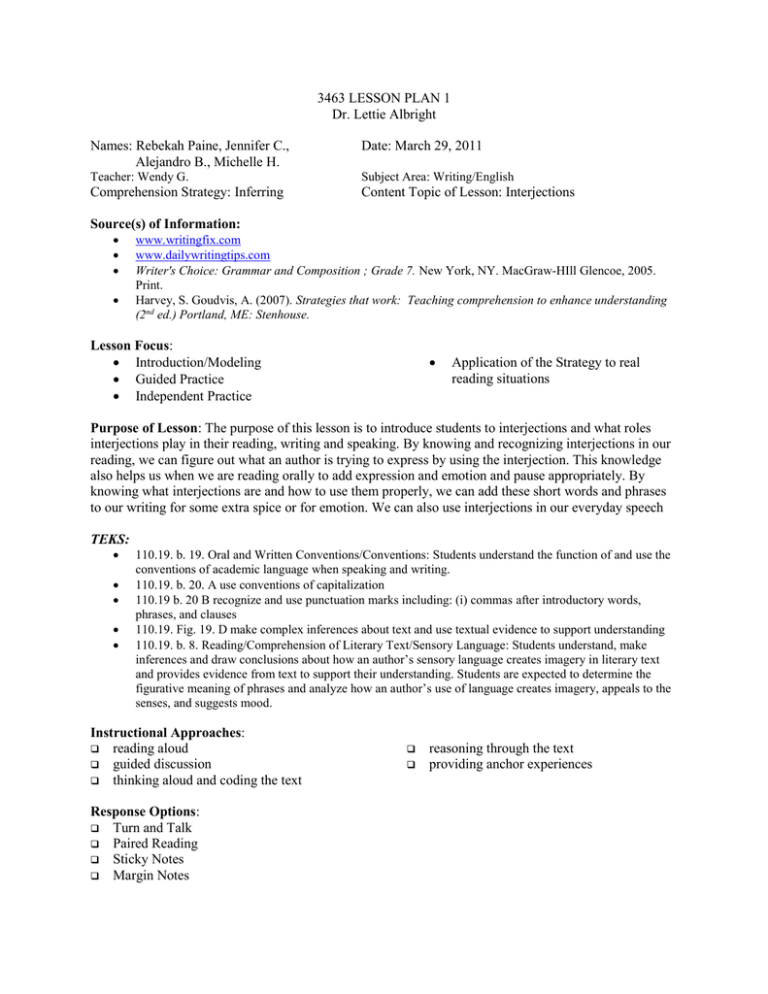
3463 LESSON PLAN 1 Dr. Lettie Albright Names: Rebekah Paine, Jennifer C., Alejandro B., Michelle H. Date: March 29, 2011 Teacher: Wendy G. Subject Area: Writing/English Comprehension Strategy: Inferring Content Topic of Lesson: Interjections Source(s) of Information: www.writingfix.com www.dailywritingtips.com Writer's Choice: Grammar and Composition ; Grade 7. New York, NY. MacGraw-HIll Glencoe, 2005. Print. Harvey, S. Goudvis, A. (2007). Strategies that work: Teaching comprehension to enhance understanding (2nd ed.) Portland, ME: Stenhouse. Lesson Focus: Introduction/Modeling Guided Practice Independent Practice Application of the Strategy to real reading situations Purpose of Lesson: The purpose of this lesson is to introduce students to interjections and what roles interjections play in their reading, writing and speaking. By knowing and recognizing interjections in our reading, we can figure out what an author is trying to express by using the interjection. This knowledge also helps us when we are reading orally to add expression and emotion and pause appropriately. By knowing what interjections are and how to use them properly, we can add these short words and phrases to our writing for some extra spice or for emotion. We can also use interjections in our everyday speech TEKS: 110.19. b. 19. Oral and Written Conventions/Conventions: Students understand the function of and use the conventions of academic language when speaking and writing. 110.19. b. 20. A use conventions of capitalization 110.19 b. 20 B recognize and use punctuation marks including: (i) commas after introductory words, phrases, and clauses 110.19. Fig. 19. D make complex inferences about text and use textual evidence to support understanding 110.19. b. 8. Reading/Comprehension of Literary Text/Sensory Language: Students understand, make inferences and draw conclusions about how an author’s sensory language creates imagery in literary text and provides evidence from text to support their understanding. Students are expected to determine the figurative meaning of phrases and analyze how an author’s use of language creates imagery, appeals to the senses, and suggests mood. Instructional Approaches: reading aloud guided discussion thinking aloud and coding the text Response Options: Turn and Talk Paired Reading Sticky Notes Margin Notes reasoning through the text providing anchor experiences Procedures: Opening Activity - The students will participate in a group activity called “Hot Seat”, to help motivate learning. 1. Prior to the beginning of class, the teacher will prepare questions related to the lesson topic, Interjections, and write them on sticky notes. Place them underneath 5-7 random student desks/chairs. (Depending upon time allotment) Can you understand how someone is feeling with just one word? Who is the famous cartoon dad that says “D’Oh”? Using only one word, how can you tell someone to get quiet? .. get a person’s attention? Give me one word to express how you would feel riding the Titan at Six Flags? … express tasting a disgusting meal? What words do you use to express emotion in your writing? 2. At the start of the class, inform the students that several of them are sitting on "Hot Seats" and will be asked to answer questions related to the topic of study for the day. 3. Have students check their desks/chairs for the strategically placed sticky notes. 4. Students who have questions on sticky notes will then take turns reading the question and attempting to provide an answer. 5. A teacher will write student responses on the board/overhead. After all questions are answered the teacher will write 10-15 common interjections on the board, (in a different color marker) and circle any interjections given during the “Hot Seat” activity. Introduction 1. Ask students “What can you tell me about these words I just circled and wrote on the board?” 2. Invite student responses and engage in guided discussion on Interjections. 3. Explain “The definition/origin of an Interjection comes from a Latin word that means “throw between”. It is usually a word but sometimes a phrase that is thrown into a sentence to express an emotion. An interjection is often followed by an exclamation point or comma, but not always.” 4. Ask students to think of a few more interjections they could add to the board. 5. Explain the lesson purpose will be to recognize and understand the appropriate use of interjections as a way to express emotion, creating a richer more exciting piece of writing. Modeling 1. The teacher will pass out the Interjections! Anchor Chart to each student. 2. Explain Think Aloud and Interjections! Anchor Chart. The teacher will read aloud/think aloud 4 pages from the interjection section in, Fantastic! Wow! and Unreal! by Ruth Heller, then model filling out the Interjections! Anchor Chart. 3. Show each illustration while you point out author’s use of interjections – “Good Grief!”, “Out of Sight!”, “Holy Cow!” 4. Interactive Read Aloud- the purpose of the interjections used in the text/ how we can infer what the author means? “I can infer she wanted to make a bold statement, each interjection stands alone and has its own exclamation point, I am going to place this under the shocked text box, plus she has snakes for hair!” Provide a bonus question if they can guess what the snake haired woman’s name is? Guided Practice 1. The teacher will ask for someone to call out an interjection from the board. The teacher will ask for the class to decide “which box on the Interjections! Anchor Chart should it be placed in?” 2. The teacher will assess whether the students need more modeling, or if they are ready for peer group work. 3. Students will form into groups of 3-4, working with the students in their row. 4. The teacher will pass out one mentor text (picture book, chapter book, article) to each group, sticky notes and highlighters, pencils. 5. The teacher will explain to the students they will work together to skim the text in search of interjections, annotating the group’s thoughts/reasoning on sticky notes or in the margins. (Longer texts will have pages bookmarked, noting where to begin). 6. Students will work together reading and discussing the text. 7. Students will record the interjections found in the text, on their own Interjections! Anchor Chart. The teacher will walk around the room interacting and assessing the student’s comprehension of the strategy. 8. Students will then be asked to share their interjection findings with the class. Independent Practice 1. Written Response- Ask students to pick one interjection from the board and write about how they have used that interjection before in their writing, or how they could use it in the future. 2. Teachers walk around room, provide help, monitor student’s work. 3. Have students turn in responses as they leave. Application 1. Encourage students to pay attention to the author’s use of interjections, read interjections with expression and pause appropriately according to punctuation, and use interjections in their own writing and speaking 2. Teacher guided discussion: Ask, “Why learning interjections might be useful to them, or others?” Prompt the students with examples of at school, home, or career benefits. Closing Activity- To wrap up the lesson have the students think of one interjection that best sums up their personality, they use all the time, or one they would never use in their writing. Go around the room and have each student share their summed up interjection. The teachers will also participate in the activity. Materials (texts and other materials): Interjections! Anchor chart Read Aloud Book: Fantastic! Wow! and Unreal! by Ruth Heller Picture Books: Chrysanthemum by Kevin Henkes Dad & Me by Peter Catalanotto Dog Lost by Ingrid Lee Mice and Beans by Pam Munoz Ryan No, David! by David Shannon SkippyJon Jones by Judy Schachner Yo! Yes? By Chris Raschka Paper Pencils Dry Erase Markers Sticky Notes Highlighters Assessment Procedures: Student progress will be monitored though a variety of formative assessments by all group members throughout the lesson. The lead teachers will be listening to student responses during discussion to check for comprehension. During discussion, the one group helper will observe student interaction, while taking anecdotal notes. The other helper will be walking around, making sure students are on task, and understanding. Listen to student responses Observe student interaction – anecdotal records Writing Responses – anchor chart, sticky notes, marginal notes, independent response.
